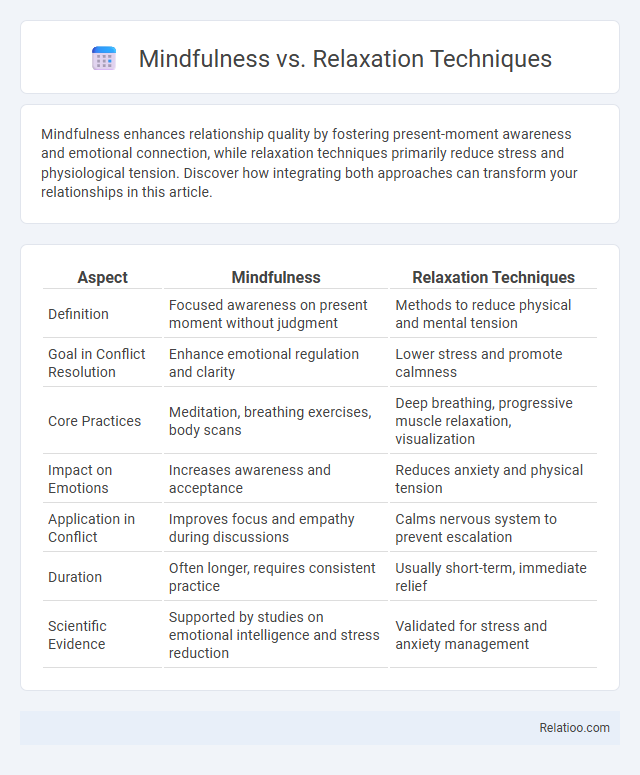Mindfulness enhances relationship quality by fostering present-moment awareness and emotional connection, while relaxation techniques primarily reduce stress and physiological tension. Discover how integrating both approaches can transform your relationships in this article.
Table of Comparison
| Aspect | Mindfulness | Relaxation Techniques |
|---|---|---|
| Definition | Focused awareness on present moment without judgment | Methods to reduce physical and mental tension |
| Goal in Conflict Resolution | Enhance emotional regulation and clarity | Lower stress and promote calmness |
| Core Practices | Meditation, breathing exercises, body scans | Deep breathing, progressive muscle relaxation, visualization |
| Impact on Emotions | Increases awareness and acceptance | Reduces anxiety and physical tension |
| Application in Conflict | Improves focus and empathy during discussions | Calms nervous system to prevent escalation |
| Duration | Often longer, requires consistent practice | Usually short-term, immediate relief |
| Scientific Evidence | Supported by studies on emotional intelligence and stress reduction | Validated for stress and anxiety management |
Understanding Mindfulness and Relaxation Techniques
Mindfulness involves maintaining a focused awareness on the present moment, which enhances emotional regulation and cognitive flexibility. Relaxation techniques, such as deep breathing and progressive muscle relaxation, primarily target physiological stress reduction and induce calmness. Understanding the distinction helps optimize mental health strategies by combining mindfulness's cognitive benefits with relaxation's physical stress relief.
Core Differences Between Mindfulness and Relaxation
Mindfulness involves maintaining a non-judgmental awareness of the present moment, enhancing Your cognitive focus and emotional regulation through deliberate attention. Relaxation techniques primarily aim to reduce physical and mental tension by activating the parasympathetic nervous system, leading to a state of calm and decreased stress. Unlike relaxation, mindfulness does not seek to eliminate stress but encourages embracing and observing it with acceptance, making the core difference one of active awareness versus passive tension relief.
Benefits of Practicing Mindfulness
Practicing mindfulness enhances mental clarity and emotional regulation by promoting present-moment awareness, which reduces stress and anxiety more effectively than generic relaxation techniques. Unlike relaxation methods that primarily target physical tension relief, mindfulness cultivates sustained attention and self-awareness, leading to improved cognitive function and resilience. Studies indicate that regular mindfulness practice can lower cortisol levels, boost immune response, and foster long-term psychological well-being.
Benefits of Relaxation Techniques
Relaxation techniques such as deep breathing, progressive muscle relaxation, and guided imagery effectively reduce stress by lowering cortisol levels and promoting parasympathetic nervous system activation. These methods improve sleep quality, decrease anxiety, and enhance overall cardiovascular health through consistent practice. Your mental clarity and emotional resilience benefit significantly from integrating relaxation techniques into daily routines, complementing the awareness cultivated by mindfulness.
When to Use Mindfulness Over Relaxation
Mindfulness is particularly effective when the goal is to increase present-moment awareness and reduce automatic stress responses by observing thoughts and emotions without judgment. Relaxation techniques, such as deep breathing or progressive muscle relaxation, are best used for immediate physical stress relief or to induce calm in high-anxiety situations. Use mindfulness over relaxation when dealing with chronic stress or emotional regulation, as it fosters long-term resilience and cognitive flexibility rather than temporary relaxation.
Popular Mindfulness Practices Explained
Popular mindfulness practices like mindful breathing, body scan meditation, and mindful walking emphasize present-moment awareness by cultivating focused attention and non-judgmental observation. Relaxation techniques, including progressive muscle relaxation and deep breathing exercises, primarily aim to reduce physical tension and activate the body's parasympathetic nervous system for stress relief. Mindfulness differs by fostering sustained conscious awareness and emotional regulation rather than solely promoting physical relaxation, making it a foundational practice for mental clarity and resilience.
Common Relaxation Techniques to Try
Common relaxation techniques to try include deep breathing exercises, progressive muscle relaxation, and guided imagery, which help reduce stress and promote physical calm. Mindfulness involves maintaining a present-focused awareness and non-judgmental observation of your thoughts and feelings, enhancing mental clarity and emotional balance. You can combine mindfulness with relaxation techniques to deepen your overall sense of well-being and resilience.
Scientific Evidence: Mindfulness vs. Relaxation
Scientific evidence indicates mindfulness enhances attention regulation, emotional resilience, and neural plasticity, whereas relaxation techniques primarily reduce physiological stress markers like heart rate and cortisol levels. Neuroimaging studies show mindfulness practice increases activation in the prefrontal cortex and anterior cingulate cortex, improving cognitive control and emotional processing. Relaxation methods mainly target parasympathetic nervous system activation, leading to immediate but transient reductions in stress without long-term structural brain changes.
Which Approach Suits Your Lifestyle?
Mindfulness emphasizes present-moment awareness and mental clarity, making it ideal for individuals seeking ongoing stress management through meditation and conscious breathing. Relaxation techniques, such as progressive muscle relaxation and guided imagery, target physical tension relief and are suitable for those needing immediate calm after high-stress events. Choosing between mindfulness and relaxation depends on lifestyle demands, with mindfulness fitting well for daily routine integration and relaxation techniques preferred for quick stress reduction.
Integrating Mindfulness and Relaxation for Optimal Well-being
Integrating mindfulness and relaxation techniques enhances your well-being by combining present-moment awareness with physical and mental calmness, promoting a balanced state of mind and body. Mindfulness cultivates non-judgmental observation of thoughts and emotions, while relaxation methods reduce stress responses and physiological tension. Using both approaches together fosters deeper stress resilience, emotional regulation, and overall mental clarity for optimal health.

Infographic: Mindfulness vs Relaxation Techniques
 relatioo.com
relatioo.com